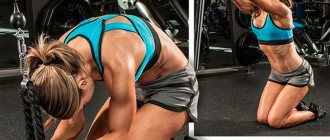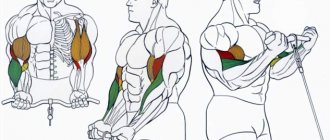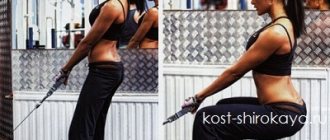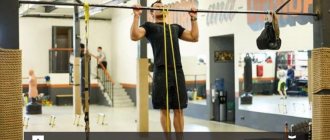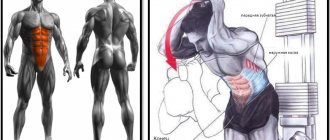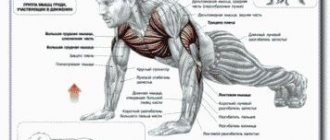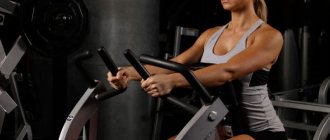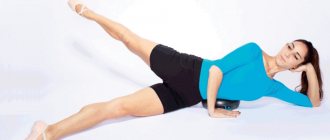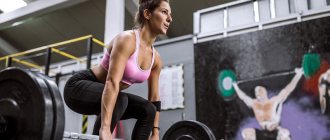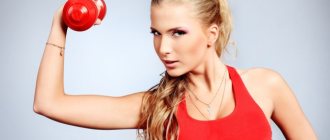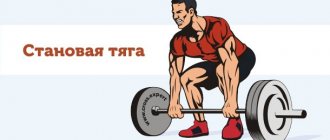10.10.2021
| 2 comments
Extension of the arms on the upper block is one of the main classic exercises in bodybuilding, aimed at working the triceps brachii muscle, that is, the triceps. As you know, the triceps occupy 2/3 of the volume of the entire arm, and everyone’s beloved and desired biceps is only a third. Therefore, if you want big, powerful and strong arms, focus on working your triceps. The exercise is isolated and targeted, so using too much weight is not entirely advisable. In this article we will look at the correct technique of the exercise, variations of execution and the main mistakes that novice athletes make.
Types of handles
Before performing the exercise, you need to decide on the choice of handle. The main types of handles are presented in five variations:
1. A short straight handle is a classic design;
2. A wide handle is used, as a rule, to work the back muscles, however, if the choice in the gym is not particularly large, then it is allowed to perform arm extensions on the upper block;
3. The V-shaped handle is one of the most comfortable thanks to its stops at the ends. Therefore, the handle will never slip out of your hands when performing the exercise;
4. Rope handle - the choice of an experienced athlete. This embodiment is quite complex. The movement of the hand here turns out to be more “alive”. The hand can “walk”, that is, deviate from the given trajectory when choosing too much weight;
5. D-shaped handle is designed to extend the arms individually. After all, as we know, a person’s muscles in one arm or leg are stronger than the other. Therefore, to prevent one hand from taking the load from the other, a D-shaped handle was invented.
Crossovers: horizontal and sitting
A more powerful exercise in comparison with the classic exercise for the chest muscles in a crossover, but extremely rarely performed by athletes. Changing to a horizontal plane, bringing the arms together, works on the mass of the pectoral muscles. To perform the training, you need to install a horizontal or inclined bench in the center of the machine and lie down on it. Crossover training is reminiscent of dumbbell curls, but it is more effective because the load does not leave the pectoral muscles for a second.
Crossover training performed “sitting” is no less productive. In this position, the legs and back are not drawn into the work, and the crossover exercise acts with pinpoint precision on the pectoral muscles, and is not “smeared” over the body.
Read also: Why do you need highlighters and bronzers?
Important: when performing horizontal hands, change the position of your hands from repetition to repetition, moving your right and left upwards alternately.
Video: Crossover on upper blocks
Working muscles
Extension of the arms on the upper block specifically engages the triceps brachii muscle, which is responsible for extending the arm at the elbow joint. It consists of three bundles (heads)
- medial;
- lateral;
- long.
As I mentioned at the very beginning: the triceps account for 2/3 of all the muscles in the arm. That is why the triceps must be given due attention in the training process. The following muscle groups are also included in the static work when performing triceps extensions:
- latissimus dorsi:
- chest muscles;
- wrist flexors;
- press;
- trapezius muscles.
Barbell Arm Extension (French Bench Press)
The exercise is quite complex from a technical point of view, so a woman or an inexperienced athlete should not perform it at first. Technique:
- Lying on a bench, grasp the barbell so that it rests on straight, vertically raised arms.
- Inhale, bend your elbows, bringing the barbell to your forehead (or behind your head), trying to keep your elbows from spreading too wide, as the picture shows. And straighten your arms to the starting position, ending with an exhalation.
Depending on the morphology (wide/narrow shoulders, wrist stiffness, etc.), the exercise may undergo changes from a technical point of view, including a basic and more complex level of load. Therefore, it is advisable to perform it with an assistant who could exercise control from the outside.
Execution technique
Most athletes think that the lat pulldown is a technically easy exercise. Alas, they are wrong. Even such a seemingly simple exercise has its own nuances and subtleties. I will not tire of repeating that correct technique is the main key to an effective training process. And it is precisely this that you need to devote a lot of time to studying.
Initial position
- Place the handle of your choice on the top block;
- Check the condition of the simulator;
- Position yourself facing the machine and grasp the handle with your hands;
- Keep your body straight, slightly tilted forward with a slight arch in the lower back;
- For better body stability, place one leg slightly in front of the other (optional);
- Using your hands, lower the handle until a right angle is formed between the shoulder and forearm;
- Fix your elbows near your body. This will be the starting position for performing the exercise.
Performance
- Take a deep breath. As you exhale, using your triceps, begin to straighten your arms downwards until your arms are fully straightened. Arm extensions should occur strictly through the efforts of the triceps;
- At the lowest point, fix your hands for a couple of seconds, thereby further contracting the muscles being trained;
- Slowly inhaling air, return the handle to its original position and continue to perform extensions the specified number of times.
Extension of the arms on the upper block should be performed after basic exercises (French press, dips or close-grip press) for the triceps. Perform 3-4 sets of 12-15 repetitions.
Before you start training
Despite the fact that the exercise is relatively simple, pay attention to a number of contraindications to its implementation.
- If your elbows hurt, it is not recommended to do the exercise until the acute pain syndrome passes. It is advisable to do an MRI of the elbow joint to clarify the etiology (origin) of pain.
- If your wrists hurt, you should also let them recover. You can try using a medium-hard hand brace. If you do extensions with them painlessly, train calmly.
- After fractures, you need to wait a few weeks after removing the cast and start doing extensions with small weights. This will help restore ligaments and tendons that have become unaccustomed to stress and prepare the joint for further weights.
Errors
Beginning athletes often neglect proper technique in pursuit of large weights. However, in this case, “the game is not worth the candle.” Below I will list the main mistakes that beginners make when performing triceps extensions.
- protruding elbows in different directions or forward;
- leaning the body forward too much;
- high speed of exercise;
- assistance with the body during extension;
- incorrectly selected weight of weights.
Conclusion
It is advisable to include the arm extension on the upper block in your training program as a good isolating exercise for the triceps. Many athletes use extensions both at the beginning of training to warm up muscles and joints, and at the end to “finish off” the muscles. Personally, I use this exercise at the end of a strength training session after heavy compound movements. Good luck, health and high sports results, friends!
Video
Arm extension with dumbbells
Arm extensions with dumbbells can be performed in various variations. When performing the exercise on a horizontal bench, the technique is almost the same as in the case of barbell extensions, but the position of the wrist changes here.
- Lying on a bench, grab a dumbbell with each hand, straightening your arms so that your hands are parallel to each other.
- Inhale, bend your elbows, making sure your elbows remain in their original position. Extend your arms and exhale at the end point.
Most inexperienced athletes cannot hold their elbows in this exercise; to do this, you can ask a friend or coach to fix their shoulders with their hands or using a belt.
This exercise works all three heads of the triceps.
As mentioned above, dumbbell extensions can be performed in various variations, and another effective option is the overhead extension. The long head of the triceps is most involved here. Technique:
- Sit or stand and lift your dumbbell arm straight over your head so that your wrist is in its natural position.
- Inhale, bend your elbow, bringing the dumbbell behind your head and maintaining the position of your elbow. Then straighten your elbow and exhale.
In this exercise, it is also important to control the position of the back and abdomen, avoiding excessive arching in the lower back. You can lean on a bench with a short back. A similar exercise can be performed with both hands while holding one dumbbell. It can also be a kettlebell, a W-shaped bar or a barbell (the so-called French seated press).
The next no less popular are bent over arm extensions. This exercise can be performed while standing or leaning on a bench. Technique:
- Stand in a stable position so that your knees are slightly bent, your body is tilted, your back is straight, your working arm is not resting on your leg, but your working arm is bent at the elbow with a dumbbell (or kettlebell) at an angle of 90 degrees and pressed against the body.
- Inhale, straighten your elbow, and exhale.
To perform the same exercise from a bench, simply rest one knee and non-working hand on the bench.
Technical errors
In all versions of the exercise, the technical errors are similar:
- Body swing;
- Forearm thrusts;
- Extension due to inertia;
- Rolling from foot to foot to facilitate movement;
- Sliding hands along the handle;
- Movements in the shoulder joint during the exercise.
These errors are caused by incorrect weight selection. The resistance should be light, then you can concentrate on working the triceps. Sometimes they object that with small weights it will not be possible to build muscles. But here you can solve the problem by correctly combining movements in your training plan. Basic multi-joint exercises such as the medium-grip bench press, dips, and classic bench press are designed to work with weights. Isolating movements – for high-quality work without cheating. Extension is performed at the end of the workout, in a multi-repetition mode, in 3-4 working approaches.
How to do it correctly?
Despite its apparent simplicity, the exercise has its own nuances. The first thing you have to deal with is choosing the right handle:
- Straight wide;
- Straight slightly bent;
- V-shaped;
- Cord;
- Knot.
If you are not a professional, then variations with a straight line, wide and slightly bent, should be immediately cut off. For one simple reason - this will fix the wrong trajectory of movement, and most importantly, the hands will not be able to achieve naturalness in movement. Well, we must not forget that they must be parallel to each other in order to achieve a uniform load.
A V-shaped handle is a good option, but it also limits your range of motion. The arms remain parallel, so when working with small weights (up to 60 kilograms), you can safely use it.
The ideal solution would be a knot. But it is not suitable for those athletes who have not yet fully learned the correct technique. After all, when working with it, you need to independently control the position of your hands.
How to approach the block correctly? Ideal exercise technique:
- Approach the block frame at an elbow distance from the handle of the simulator;
- Tilt the body slightly - about 10-15 degrees.
- Place your arms parallel to each other.
- Unbend them, pulling them towards the belt.
Deadlift from the lower block
Targeted muscles:
- biceps femoris muscle;
- buttocks.
Procedure for performing the exercise:
- grab the horizontal handle or cable attached to the lower block and step back;
- wait until the weights rise and create tension in the cable;
- With your knees slightly bent, your lower back arched and your buttocks pulled back, lower your body down until you feel a deep stretch in your hamstrings;
- hold in this position for 1-2 seconds;
- slowly return to the starting position;
- At the end of each rep, arch your lower back and squeeze your glutes.
Why do this? The exercise is a worthy alternative to the traditional straight-legged deadlift with a barbell or dumbbells. When performing it, constant tension is created throughout the entire amplitude of movement, which improves the neuromuscular activity of the target muscles, and also gives a powerful pump to the hamstrings and buttocks.
Useful tips
- You don't need to lean forward too much. In this position, you will be pressing down on the working weight with all your weight, so your triceps will receive less load. This technique is called cheating and is not allowed in the training of novice athletes.
The elbows must be in a stationary position, because otherwise the exercise will resemble a bench press.
In addition to the iron handle of the machine, the exercise can be performed with straps or ropes. The straps make it possible to turn your hands with your palms up when you reach the top point of the amplitude. This movement causes additional contraction of the triceps and makes the entire exercise more difficult. Because of this, it is recommended to set a lower weight in this case.
It is very important to straighten your arms all the way to give your triceps a good stretch.
The back should always be straight. At the same time, the chest turns forward. To give more stability to the body, you can put one leg forward. This makes it easier to maintain a stable position of the spine.
Crossover shoulder exercises
The crossover is a block exercise machine, the design of which allows you to perform a wide variety of exercises for all muscle groups. Thanks to its multifunctionality, the crossover has become widespread and can be found in almost any gym. This popularity, multifunctionality and ability to level out some of the technical flaws that beginners make when performing exercises with free weights forces us to touch in more detail on the topic of integrating this simulator into the training process. In this article we will talk about crossover exercises for the muscles of the shoulder girdle. Why shoulder exercises?
The importance of the shoulder girdle is difficult to overestimate! For men, the shoulders complete the silhouette of the upper body; for girls, the shoulders emphasize the fragility and femininity of the figure, while simultaneously helping to create the illusion of a “wasp waist.” For men, of course, the basis of the entire training process is high-intensity cycles, during which heavy basic exercises are used, etc., but, firstly, beginners must “pump up” for some time, and, secondly, after intense cycles so there is always a high-volume cycle, during which the athlete also... Can this be done with free weights? Yes, it is possible, but beginners do not have sufficiently developed technical skill for this, and more experienced athletes often experience injuries that force them to resort to tricks. But even if there are no obvious reasons, then for the sake of variety or for personal reasons you can integrate crossover shoulder exercises into your training without fear of losing its effectiveness.
Correct technique
advertising is not displayed
- It is necessary to take the correct starting position. It depends on which simulator this exercise will be performed on. Most of them have a comfortable buttock and knee pad. The athlete should kneel on the pillow and grab the levers with their hands.
Some machines have special pads for the elbow joints. In this case, the hands are placed on them so that the elbows rest completely on the pillows.
By relaxing the shoulders and inhaling, the athlete places the spine in a neutral position. After this, you can begin to unbend the handles of the simulator. They rise smoothly as you inhale, and then fall as you exhale.
The required number of repetitions is performed. On average, it is recommended to do 15 to 20 curls. The working weight for male beginners does not exceed 20 kg, and for female beginners – 10 kg.
